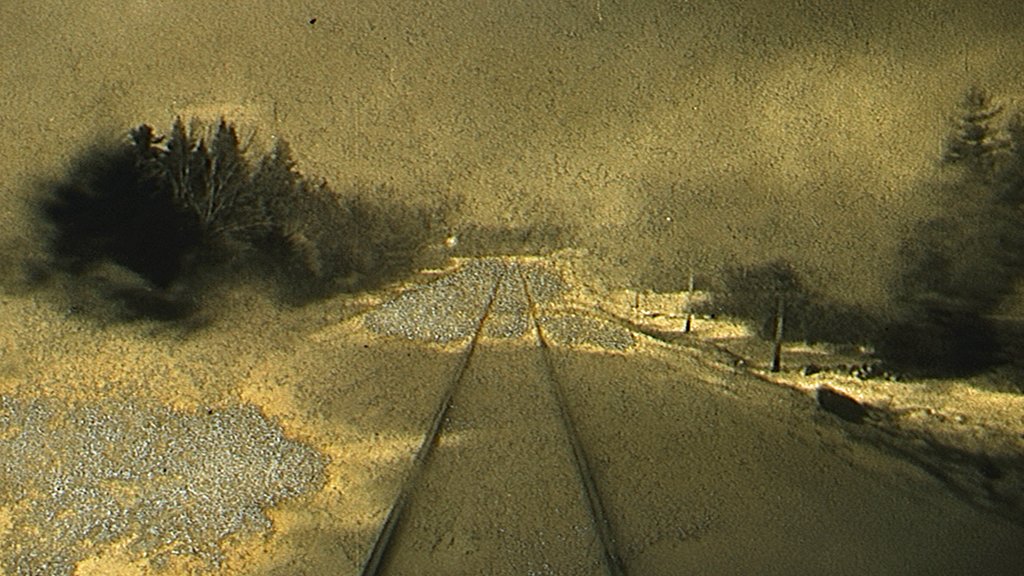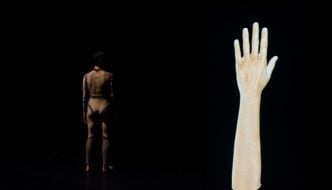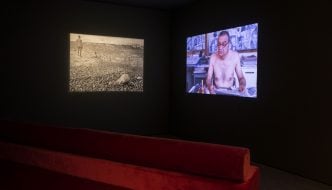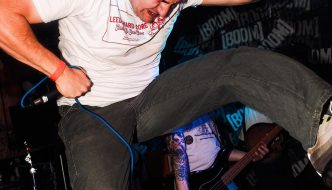 As darkness began to descend over Edge Hill Railway Station, a train stopped to let its passengers off. Some of them looked back curiously towards the old carriage ramp, where they could hear music playing – and wondered briefly what was going on – before they left the station to continue their journeys home.
As darkness began to descend over Edge Hill Railway Station, a train stopped to let its passengers off. Some of them looked back curiously towards the old carriage ramp, where they could hear music playing – and wondered briefly what was going on – before they left the station to continue their journeys home.
The evening’s open-air performance of Steve Reich’s Different Trains Live had been laid out like a festival site. Stalls on one side of the platform, where attendees of the performance could buy beer, food or tea, and on the other side were tables and porta-loos. Further forward on the right-hand side were benches that led down to a stage, fitted with a large screen, and to the left of that, a mixing desk.
This event was presented by Metal, who are based at Edge Hill Station, and the project had been set up for the Liverpool Biennial in association with the Southbank Centre, Culture Liverpool, and Boiler Room.
By the time that the show was due to start, the place was crammed with about 1200 people, who had come from all over the country to see it. The air hummed with excitement and it became apparent that something very special was about to happen.
There were going to be two parts to the concert, the first was to be a performance of Electric Counterpoint, another of Steve Reich’s compositions, and the second was to be Different Trains, performed live with music by the London Contemporary Orchestra in collaboration with Sound Intermedia.
It was held just days before the composer’s 80th birthday and he was in attendance along with his friend, the filmmaker Bill Morrison, who had been commissioned to do a new film for the occasion to accompany the piece.
To begin proceedings, Jude Kelly, founder and chair of Metal, spoke passionately about the importance of culture and the arts in society, and of how Edge Hill Station is the ideal location for this event as it is believed to be the oldest active passenger railway station in the world, then she handed over the microphone Steve Reich and Bill Morrison to say a few words.
It was obvious that both men were overwhelmed by the turnout and Morrison even joked that Reich had commented earlier that this was probably going to be the first ever Rave performance of Different Trains in the world, then he introduced Mats Bergstrom, who was going to be performing Electric Counterpoint.
He took to the stage and started playing the atmospheric guitar piece, which was backed by an audio track, whilst a film on the screen showed the sun rising over a calm sea that got rougher as time progressed.
As the tune mellowly echoed into the night, the artist seemed to get into the spirit of things and looked like he was enjoying himself as nodding his head in time to the music while the trains rattled by over the wall beside him, sometimes fitting in with the music themselves.
It lasted for about half an hour and then there was a brief interlude while the crew set up for the main event of the evening, Different Trains. During this time, there was a short rain shower and a few lightning strikes could be seen in the distance, which seemed to fit perfectly with the smooth jazzy music that was playing over the speakers and thus adding to the atmosphere.
Then, all of a sudden, the dark stage lit up and the orchestra began to play rapidly on their stringed instruments making a sound that suggested that trains were moving along a track. The music was accompanied by whistles, melodic speech which was sometimes repeated, and a film which had been synchronised to fit in.
The first scene was of the view along the track as a train ran towards it, then there was another of a train running towards us. This reminded me of that early film where the audience ran out of the cinema thinking the train was going to come through the screen, but unlike then, people knew that wasn’t going to happen, so everybody just continued to watch… albeit some clinging to their seats.
As the film progressed, there were views from train windows, of tracks being pulled up and harrowing scenes of Jews being led to the death camps in World War 2. At this point the music slowed down, then as we left the death camps, it sped up again as we were shown the images of moving trains and scenery again.
It only lasted about half an hour and once it had finished, Steve Reich and Bill Morrison came back on stage to be cheered and applauded enthusiastically by the appreciative crowd, all of whom seemed to have been moved by this thoroughly expressive piece.
As I left Edge Hill Station that night with the music still going round in my head, I knew that I had seen something memorable and unique. My mind was full of mixed emotions caused by the images that I had seen on the screen, but I was also extremely satisfied. It was a fantastic experience that I will never forget.
You can still catch the Different Trains film at Edge Hill Station until the 15th of October. Check out details for the event—and listen to the soundtrack—here.




Comments